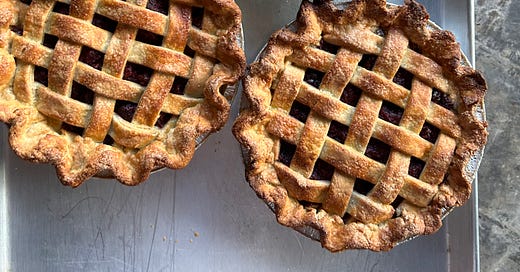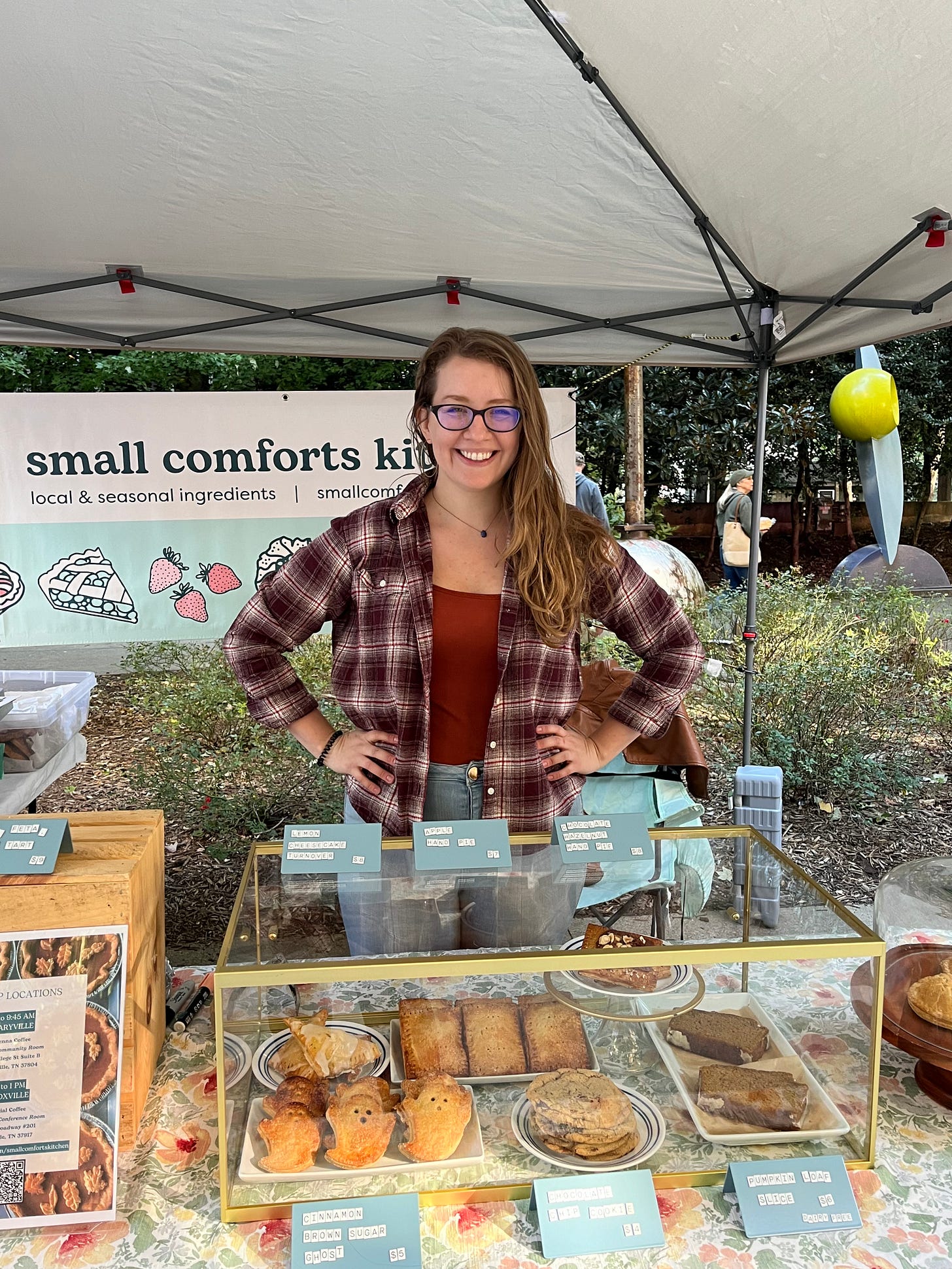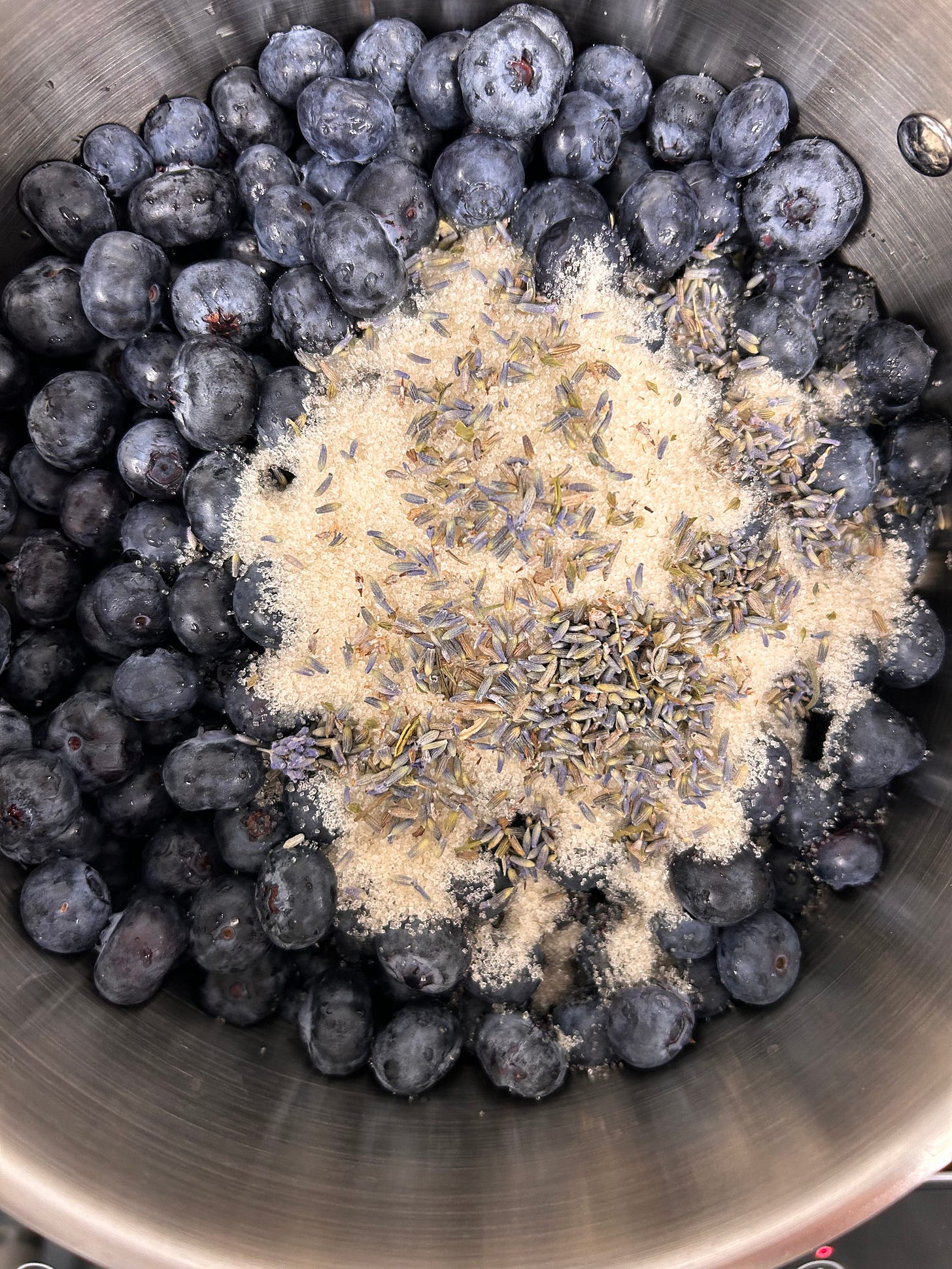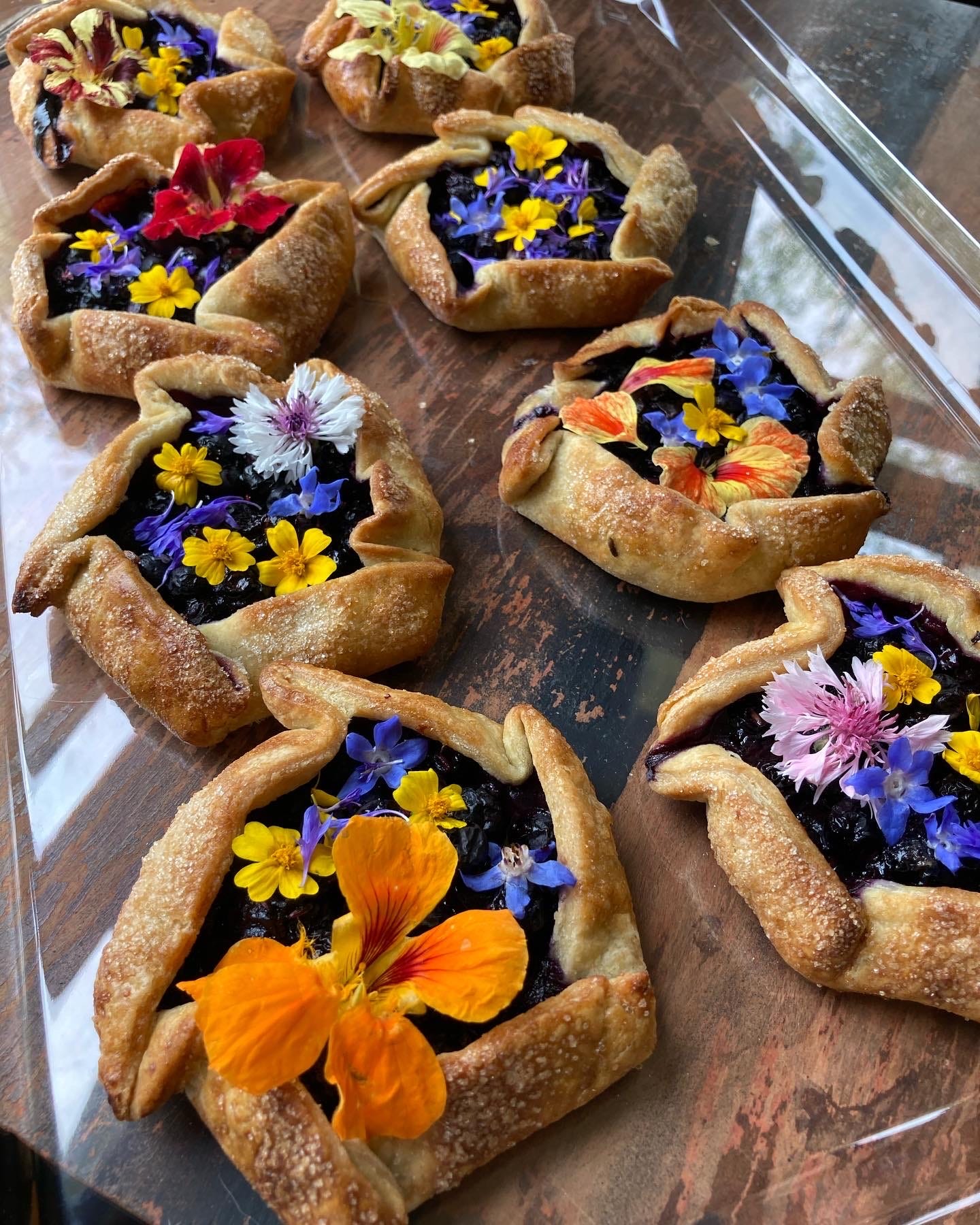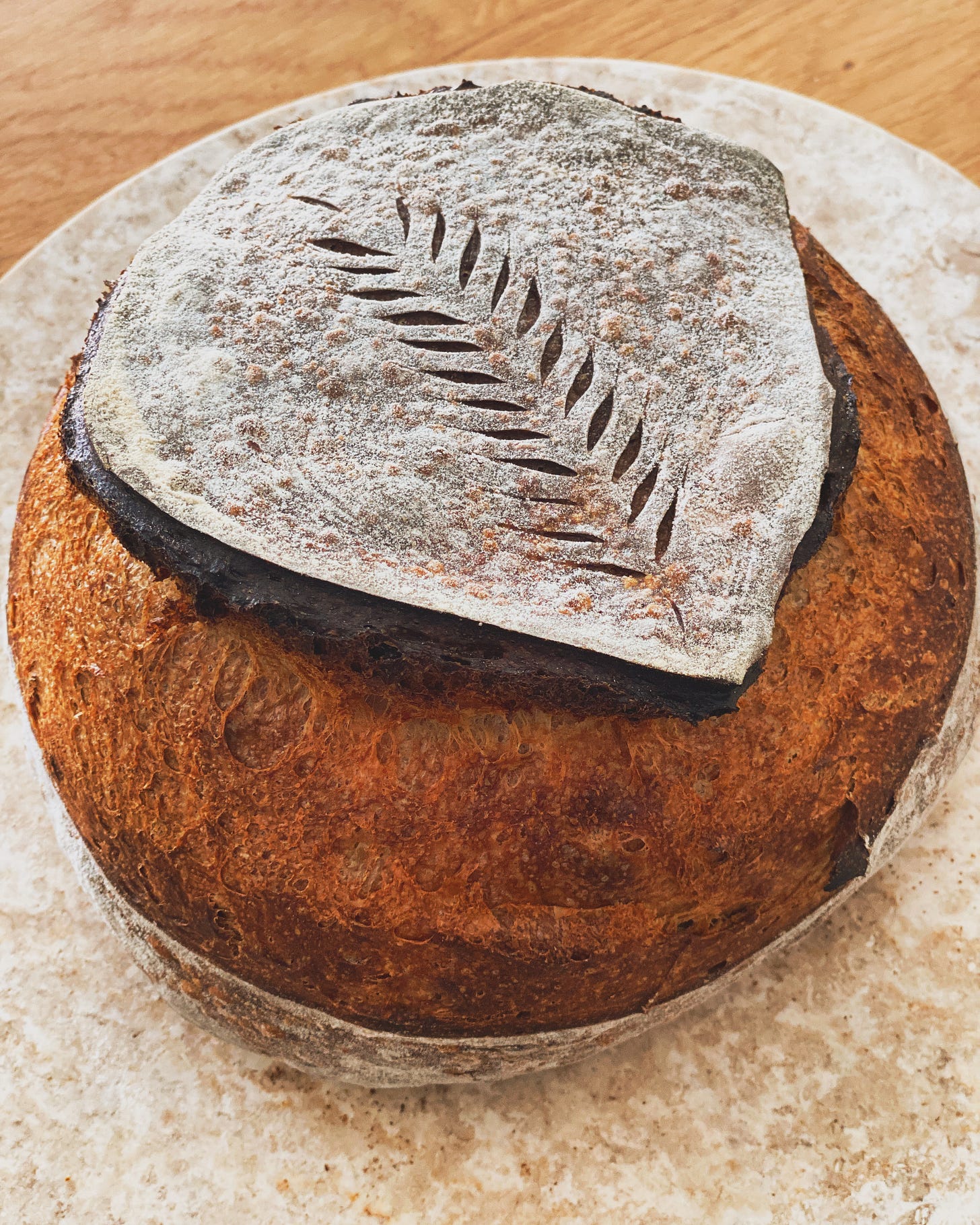Hello and welcome to Letters to Beloved, a newsletter from Ali Bakes Bread! If by some miracle, you’ve found your way over here but are not yet subscribed, here, let me help you with that:
Before we dive in, I want to give you a heads up about some changes coming in 2025 to the newsletter. Until now, regardless of whether or not you have a paid subscription, every newsletter has been 100% free and available to all readers. Beginning in January, paid subscribers will get immediate access to the full letter. Free subscribers will still be able to read the Baker’s Note but any interviews and recipes will be paywalled until the following month. So you’ll still get to read the full letter, but it will require some patience ;)
There will also likely be some exclusive content for paid subscribers, but we’re still working out the details.
If you’d like a paid subscription but can’t swing it financially, send me a message on Instagram, and we’ll work something out.
As always, thanks for reading <3
Baker’s Note
One of my favorite restaurants is Superiority Burger, a mostly vegan and all vegetarian place in New York run by Brooks Headley. Their old location was this tiny spot in the East Village. They cooked in the basement within cramped, narrow spaces, working with whatever equipment could fit. In an interview, Headley talked about how restrictions inspired creativity. Working in a confined space forced his team to be more innovative.
In Headley’s words: “The gluten-averse have been integral in shaking up my kitchen creativity.” Accommodating allergies and dietary restrictions pushed him to rethink old classics and figure out the drivers of texture and flavor rather than simply falling back on traditional ingredients, formulas, and methods.
It reminds me of advice for writing fiction that George Saunders gave me. The vastness of an empty page and a story that can literally go anywhere is daunting. But if you force yourself follow some arbitrary rules—I need to write a crime noir set in Boston and include a kangaroo.—well, now you’ve got some direction and a story begins to take shape.
I don’t always respond well to limits or restrictions, but when I feel adrift and uninspired, giving myself some rules to follow sometimes breaks me free and reveals something new. So that’s my challenge for the month—follow three rules to possibly inspire something new or something creative. Here’s what I have for December:
Bake a dessert that includes freeze-dried strawberries.
Use an ingredient I’ve never used before.
Share something vulnerable with an old friend I haven’t talked to in awhile.
Next month, I’ll let you know how that goes.
xoxo, Ali
Comfort Food
I met Jordan Smith nearly ten years ago when she volunteered to teach a creative writing/yoga class for fifth graders. We both ran in the same literary circles and had aspirations to write fiction but have since discovered baking as our preferred creative expression.
Jordan runs Small Comforts Kitchen, a gluten-free microbakery in Knoxville, TN. She was kind enough to jump on a call with me and talk about how she not only discovered baking, but also launched a business around it. She was also gracious enough to share her just-in-time-for-the-holiday recipe for blueberry-lavender pie filling.
Here is our conversation:
When did you first fall in love with food?
It's funny because I think many people have a core family memory around food that's really deep and driving them. I can certainly think of things I made myself when I was younger, or things my mom made that meant a lot to me, but a lot of my food interest came from pop culture. There was this television show called Pushing Daisies that was on when I was in high school. The main character was a pie maker - this strange kid with magical powers who was a little bit of an outcast. It was very much a Technicolor show with musical theater elements, so it was right up my alley. I found myself entranced by this outcast pie maker character.
I had that in the back of my brain, but I can't really think of a moment when I was young where I knew food was absolutely what I wanted to do. I started to become more interested in it when I was in college and found myself without a kitchen in a dorm room. I realized it was actually something I enjoyed even though I wasn't consciously pursuing it. I had this thought of maybe dropping out to go to culinary school, but then I was diagnosed with celiac disease and that just really shut everything down. For a while, I was pretty disconnected because of the dietary restriction thing.
Wow. So staying on that, can you tell me about the 52 Pie Challenge you did? Specifically I’m interested in how you said that “the project completely rerouted my life plan for the better.”
I was in Austin collecting literary-related jobs and thought I was at least going to be an editor. Maybe a writer. I was doing these things but never quite finding my footing in the community. I wasn't writing, though I had done some food journalism and food blogging, which I really relied on during periods of depression. Then I ended up having a major breakdown and moving to Tennessee to live with my family.
At that point, I decided everything I'd done up to this point had been a mistake. I would make the safe choice and go to library school. Whether in academia or a public library system, the hierarchy is pretty clear, and I thought that's what my brain needed. I wasn’t enjoying it, but I had committed to finishing it though, and was in my last semester.
The whole time, food had been pulling at me. During my last semester of grad school, I decided I needed a stress release, and I came up with this goal to bake 52 pies in a year. I really didn't think I would complete it since I'm typically not a person who keeps resolutions of any kind. But it just stuck. The structure of a recipe and trying to get as good as I possibly could at this one thing really lit me up.
I hadn't intended for it to be anything beyond my personal project - maybe a blog at most. But Knoxville happens to have a really aggressive Instagram culture, and it's a smaller community. I found myself getting followers and attention, and enough people in the business world said to me, "You could make this a business." I was also struggling under the weight of ingredient costs, so I decided to just do it. It just sprung out almost fully formed, like "okay, this is what you're doing now."
My very next question was “When did you think you could do this professionally?” That kind of leap must have taken a lot of courage. Did you have support? Or people who tried to talk you out of it?
I have always been a bit of a pinball machine, and with other ideas I had for changing my life in the past, loved ones would question if it made sense. But with this, they were just like, "No, you're good at this." In general, people in my life who hadn't always been as supportive of other potential career changes were saying this makes sense. They could see how happy it was making me - nothing else ever had - and how focused it was making me.
I had always struggled after college to give myself structure. I was very much a school person, so when I wasn't getting graded anymore, I felt lost. Going back to the 52 pies, there was a point when I started making hand pies, which is mostly what I make now - small rectangles or circles filled with jam. It was so fussy and annoying but so delightful. I just wanted to do it over and over.
I loved how with pie you have this consistent base, and then you can easily swap in flavors. I started thinking about seasonality in a way that had already been part of my life and pulling all of that in. I noticed that no one else in my area was doing this. That, plus the gluten-free thing - almost no one in Knoxville or nearby was doing what I had been trying to do, but especially not gluten-free.
Being gluten-free seems less like a restriction and more like a creative superpower. While traditional bakeries primarily use wheat flour for their pies, you've had to experiment with different combinations of ingredients, which seems to open up more possibilities for flavor. Could you talk about your philosophy with gluten-free baking? Does it feel like a creative sandbox rather than a restriction?
The only time I feel restricted is when I see the ease of other people's production processes. Like anyone else, I pull a lot from cookbooks and food bloggers. I think my skill lies in spotting good recipes. The base for my flour blends isn't my unique creation - I didn't stand in the kitchen testing endlessly. I let recipe development bloggers do that work for me. That's important to talk about because people think pastry chefs are gods who have endless time for testing, but most bread bakers are reading Tartine and pulling from that.
I have a bit of a chip on my shoulder about being boxed into the gluten-free category, with folks not wanting to try it because they assume "gluten-free is not good." But when we think about our food systems, it's important not to be so limited in our palettes. There are so many interesting grains - like millet, which I use most often. I've had fascinating conversations with people from other countries about different flours that aren't commonly used in their regions, and it's been a really cool portal.
Baking without gluten means compensating to create elasticity, so I hydrate the dough more and keep it warmer to achieve a good stretch. The goal is for the crust to look nice rather than crumble apart. I’m always experimenting to get a consistent result, even though I’m often just winging it based on what I’ve learned.
A few years ago, I had a period where I wasn't reacting to gluten and ate wheat for the first time in decades. It was not a smart choice as someone with celiac and I don’t recommend it, but it wound up being informative for me. I found wheat to be strangely sweet. Things like croissants are probably better with gluten, but other items like cakes or pasta I found lacking in complexity and weirdly sweet compared to other grains. I don't recommend anyone do that, but it was interesting to realize that even if I could suddenly bake with gluten again, I would maintain many of my current recipes because I think they're just as interesting.
You and I had very similar experiences with the literary community - that feeling of struggling to figure things out, sometimes writing and sometimes not, never quite knowing how to make it work. But with baking, it seems like you intuitively found your way. The grains, flour, and pie just make more sense to you. It's interesting how you can think of yourself one way and then fall into something completely different and realize "this is what I was meant for." Somehow baking just clicks for you in a way your previous life didn't. Can you talk about that?
I've realized that I'm a very in-my-head person. I was talking to my partner about this recently - he's also creative, but he goes through his day generally viewing the world around him as it's happening. I typically have the world and also another screen going in my brain, thinking about something entirely different. Writing put me too much into that back half of my brain where I couldn't really see the world around me.
The difference for me between writing and baking is that while they provide the same creative satisfaction, with baking I can see the good in front of me. I'm able to physically toggle it in a way that I never could with a piece of writing or many other things in my brain.
That's really well said. Do you remember the first gluten-free recipe you developed - maybe a hand pie - where you thought, "Wow, I'm really onto something here. This is something people would pay for"?
The recipe I'm going to share with you, the blueberry lavender filling, was something I made for a hand pie. Lavender is hard to work with - much like cardamom or rose, it can get soapy pretty quickly. I definitely looked at multiple sources to give me a starting point, and I happened to stumble upon the right ratio. It's the one thing I still make that I've eaten multiple times and still go "Damn, that's good."
And it’s super simple—like, that’s the thing. When I can find something that’s just so simple, yet so unique. When I made it, we had blueberries in season here, so I started to see those things align. I was finding the creativity that I crave in gluten-free baking from the things that I was making.
A challenge I often run into with customers is that a lot of gluten-free folks just want to recreate their past experiences. They want something they can’t have now that tastes like what their mom or grandma made, or maybe a favorite sandwich from down the street. They’re really focused on the past. I don’t mean that negatively, but for many people when I say, “Here’s this unusual thing I made,” it’s just not as interesting to them initially because it lacks that nostalgia factor. They need to trust you first.
I’ve often felt bored as a gluten-free person because I couldn’t find versions of the things I saw on shows like The Great British Baking Show. So realizing that I could make something creative and gluten-free—and that most people couldn’t even tell the difference—was a light bulb moment. I thought, “I can actually do this. I did it.”
Over the years, I’ve watched you develop a distinct point of view in how you arrange and artfully decorate your creations. You use edible flowers and other elements in such a unique way, creating a look that’s very much your own. Could you talk about how that design aesthetic has developed over time and how you arrived at it?
I’ve come to understand my strengths, which lean toward a kind of artful chaos. I have a tremor in my hands, so I’m probably never going to be someone who can pipe intricate designs. But I can highlight the beauty that’s already there in nature. When I do something a bit more detailed, I often rely on edible flowers, which I try to source from local farmers.
Another key element for me is light, as corny as that may sound. I always aim to photograph my work in the most natural light possible. It can look a little ridiculous—I work out of a warehouse in an industrial part of town, surrounded by parking lots and trash. I’ll walk around with a sheet tray, searching for just the right light. I’ve even set a tray on the ground in the parking lot to capture the perfect angle, adjusting as the daylight changes.
I have skills, but I prefer things to stay a bit unsteady, if that makes sense. I’m not aiming for a super-refined look. I like things to feel accessible. I went through a similar phase when I taught yoga briefly in my early 20s—I didn’t want it to become something inaccessible. I wanted to stay grounded and connected; I didn’t need to be doing handstands. I feel the same way about my baking.
I like keeping things rustic, maybe even a bit lazy. I have someone who works for me, and I’m always telling them, “You’re being too precious—it’s just pie.” You don’t have to put an egg wash on everything so carefully. It’s not just about moving faster; it’s that pie doesn’t need to be a perfect, polished thing. Pie is humble, even if it’s hard to make well. It’s always about home—it’s not something meant for a museum.
Can you tell me about Small Comfort Kitchens? I was really struck by the phrase “sharing pie, building community,” and I’d love to hear more about what that means to you. How do you see pie and pastry as a powerful, unique way of building community?
That mission statement—“sharing pie, building community”—is something I’ve thought more about recently, especially after the election, as I’ve looked for concrete ways to connect my business to the community. When I originally wrote it, I was thinking about how people with dietary restrictions, like gluten-free folks, often end up excluded from gatherings. There are plenty of moments around tables where you feel like the “weirdo.” I’ve been lucky enough to have had some amazing experiences, like my book club, where the members made everything gluten-free without me even asking. That kind of inclusivity doesn’t happen often, though.
There are ways that we just don’t get the full experience when it comes to sharing food—whether it’s with family, at work, or in social gatherings. Most of the time, it doesn’t bother me because I expect it. But there have been moments that were hard, like being at a function where there’s nothing for me to eat, and I’m unprepared, hungry, and expected to participate. I wanted to create food that’s so good that even those who don’t need gluten-free options would still want it, so everyone at the table can share the same experience.
Of course, there are always people with other dietary restrictions, and I know my focus on gluten-free baking doesn’t include everyone. But I got a chance to create an inclusive experience recently at a “long table” dinner. I’m not sure where the concept originated—maybe California?—but there are pop-up dinners in Knoxville where they set up a beautiful long table, and people sit next to strangers, experiencing a meal together. It’s not tied to any specific restaurant; it’s just a one-off gathering.
I collaborated with a friend at the shared commercial kitchen who specializes in North African food. When he invited me, I asked him not to feel pressured to make everything gluten-free, but just to let me know the ingredients so I could answer customer questions. But he decided to make the entire meal gluten-free. It was a small gathering, just 24 seats, and many of the attendees didn’t even realize they were eating gluten-free food. The focus wasn’t on the restriction; it was simply about enjoying the meal together.
It was a really emotional experience for me, seeing everyone just enjoying the food and sharing a community experience without focusing on dietary limitations. I haven’t posted about it because I can’t quite find the words to express what it meant to me, but it was incredibly meaningful to create that kind of inclusive space.
That’s beautiful. Cooking and sharing food are intimate acts, and being excluded can be painful. When it’s gluten-free, it’s about making space for everyone at the table.
If you don’t have to navigate the world with a dietary restriction, it’s simply not a neural pathway that exists for you. It’s often just an oversight because people have no context for it—but that doesn’t mean it doesn’t have an impact. Absolutely, it does.
To me, that’s such a powerful moment. There’s nothing more to say—just, “Done.” Then you show up, and the whole meal is gluten-free. It’s an incredible gesture, extending themselves to show they care, making you feel like you belong at the table and that you’re invited to partake in everything, not just some things. It’s truly profound.
Inclusion is definitely the goal, but I struggle with the expectation that, because I cater to one restriction, I can cater to all of them. It takes a certain amount of expertise and care. There have been situations where someone made me a gluten-free baked good, but I didn’t feel comfortable eating it. Without the right knowledge, an attempt to accommodate can actually end up causing harm.
It’s a whole conundrum—cross-contamination can happen in unexpected ways, like using a knife with crumbs on it in the mustard or missing an ingredient in the salad dressing. So, on one hand, I absolutely want to be considered; on the other hand, I don’t always trust it. It’s a delicate balance between skill, expertise, inclusivity, and safety. Sometimes it’s not true inclusion; it’s just the appearance of it.
Are there any new menu items or ideas you’re experimenting with for the bakery? Do you have plans to expand, or what’s next for you?
I usually have at least one non-pie item on the menu each week, though I’ve kept things fairly streamlined. Since I rent my commercial kitchen space by the hour, I have to be very mindful about maximizing every hour for profit, which means making the same product repeatedly. It’s helped me grow steadily, but personally, I’d love to add cinnamon rolls and other family recipes, especially as we move into the holidays. In 2025, I want to start offering these to customers.
I’m hoping to open a brick-and-mortar location. It’s scary, but I’m outgrowing the shared space. I’m in a tiny room designated as gluten-free, and I’m busting at the seams—not because of overwhelming demand, but because I don’t have the capacity to make what I need to grow that demand. I’ve looked at some commercial spaces, which is daunting; real estate and loans are no small challenge.
For me, that community aspect feels tied to having a physical space. I’ve considered staying in the shared kitchen, but I really want a place where people can gather and feel safe about what they’re eating. I know how important that is and how affirming it can be. My partner doesn’t have celiac, and he doesn’t bring gluten into our home, so I always know it’s safe for me, and I’d like there to be more places like that.
There’s only one other gluten-free bakery in Knoxville, so I envision a pie shop more than a full-service bakery. We’d have other items, but pie and comfort food would be the focus. The word “comfort” in the name was initially accidental, but it’s worked out well. For me, comfort food doesn’t necessarily mean traditional dishes; it’s about things I enjoy, with a little Texas inspiration and a focus on seasonal, local produce here in Tennessee. I’m really excited about it.
Taste This
Blueberry Lavender Pie Filling
This recipe makes filling for one 9-inch whole pie OR 6-7 galettes OR 10-12 hand pies.
Use your favorite pie crust recipe – store bought or homemade – of your choosing!
Ingredients
3 cups blueberries
¼ cup sugar
1.5 tsp culinary grade lavender buds
2 tbsp cornstarch
Juice of 1 lemon (or roughly a tablespoon)
1 tsp vanilla
Rinse blueberries and transfer to a saucepan if pre-cooking for hand pies; if not, use a regular medium mixing bowl.
In a separate bowl, combine sugar, lavender, & cornstarch, mixing until the cornstarch is evenly distributed in the sugar and you don’t see any clumps. (This is important: combining the cornstarch & sugar ahead of time ensures that you don’t end up with white starchy clumps in your filling.)
Add to the pot with the blueberries along with the lemon juice and vanilla.
If you’re using this in a pie or galette, you can stop here! No need to pre-cook. A 6-inch round of dough will make 1 galette with ⅓ cup of this filling.
If you’re making hand pies, cook the filling by bringing to a slow boil, stirring often with a heatproof spatula or spoon, just to keep the blueberries from burning on the bottom of the pan. As the mixture heats, the berries should start to look like shiny jewels. When the berries start to burst gloopily, and the juices have thickened and turned a shiny pinkish-purple, you’re done! Set aside to cool.
When I’m making hand pies, I personally prefer to make my fillings far in advance, freeze them, and then defrost the day before use. After freezing, you may think the filling seems a little dried out, but really this makes it easier to add more filling to your hand pies without it all leaking out during assembly. Once the hand pie is baked, the filling is as juicy as ever! My hand pies are usually “pop tart” shape, assembled from two 3-inch x 4-inch squares of dough. You can usually jam between 1-2 tbsp of filling into one of these.
Whatever pie type you choose, always egg wash and sprinkle with sugar before baking for the perfect golden color!
—
Thanks for the recipe, Jordan! Please let us know in the comments if you have questions. And if you made the recipe, please let us know how it turns out!
Fresh Jam
This month, I flew to Islamabad to visit my mom and keep her company. A few days into the trip, I caught a nasty stomach virus and spent most of my time eating applesauce and watching movies. Fortunately, one of those movies turned out to be one of my favorites of the year.
Dìdi (弟弟) is as much about growing up as a third culture kid as it is about that 2000s liminal space between MySpace and your first Facebook account. It’s the first movie I’ve seen that captured the texture of being a teenager in that specific decade: the savage politics of your MySpace Top 8, gossiping on AIM, pretending you’ve seen movies because others to think you’re cool, feeling less than inadequate even amongst your closest friends. It helped that I was watching the movie where I also grew up. I moved to Pakistan when I was 13. Watching Dìdi was visceral. I was time traveling.
This month’s recommendation is a two-fer. The soundtrack features a new song from pop-punk band Motion City Soundtrack that I can’t stop listening to. “Stop Talking” will feel all at once familiar to fans of their earlier music (God, remember that earworm “The Future Freaks Me Out”?).
If you can handle re-experiencing peak teenage cringe, I highly recommend both.
The Bread Queue
I just got back from Pakistan, so we’re a bit behind on our baking schedule but hoping to gain some ground these next few weeks. Coming up on the queue this month is Tiff Tran, Sheema S, and Richard Deulofet-Manzur. Thank you for letting me bake for you.
Another thank you to all of the subscribers for supporting this newsletter that supports the bread project <3
—
That’s volume #3. We’ll be back next month with another round. Please reach out, let me know what you liked, didn’t like, and if there’s anything I should eat or try.
If you’re interested in becoming a paid subscriber and supporting the bread project, we’d love to have you.
Looking for free bread? DM @alibakesbread on Instagram to get on the bread queue.

